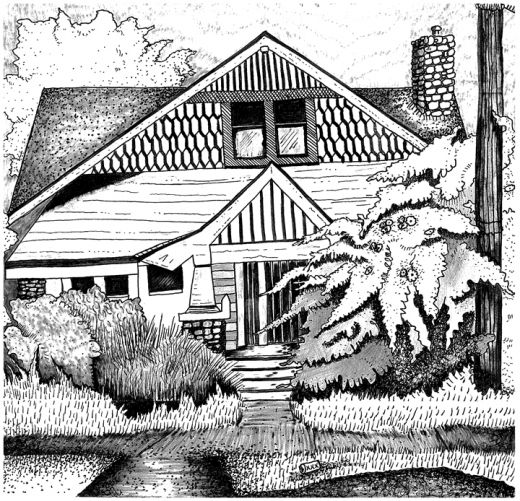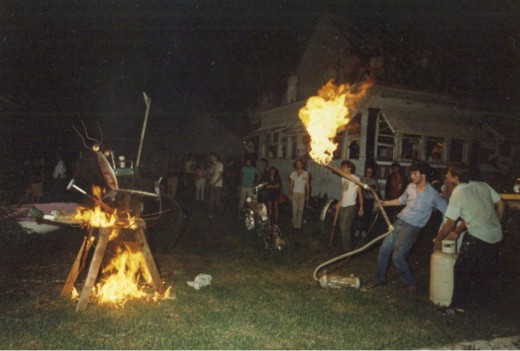
Illustration by Dorys Bello.
Tachmes, who is also a part-time gallerist, asked artist and curator Carlos Rigau to live in the house and use it as a gallery. Rigau was joined by the art collective Viking Funeral (Carlos Ascurra and Juan González), and de la Cruz Collection Director Ibett Yanez. The group founded the space and Ascurra coined it General Practice after seeing the phrase on a billboard. Openness and experimentalism are its guiding concepts, with a dedication to artistic content that is dark, malevolent, and feel-bad. They wanted a space freer of the constraints found in typical art settings, one unencumbered by the drive to make a profit or a name for itself. They got it, and then some: the house has proven to have a value and a power outside of anyone’s control.
General Practice has hosted art shows, music, performances, and parties; it has acted as a hostel for visitors from New York, Chicago, Berlin, South Africa and elsewhere. It served as the set for a low-budget indie flick called Ectotherms and a pornographic film by the Brazzers production company. Domingo Castillo of the end/SPRING BREAK was the first to live there, describing it as a “sanctuary” where he could “read, work, and reel from a [then-recent] breakup.” A guy lost control of his car, took out a fence in the front yard, and sustained Phineas Gage-level brain damage. Rigau developed a rapport with those on the block, and agreed to let a neighbor throw parties at the house. One was a booty dance party where “everyone was visibly packing heat… but they left promptly at 2 a.m. and left it cleaner than any art show thrown there.” The next one was a birthday party for the neighbor’s 14-year-old cousin.
Artistically, the house has been a testing ground for methods—some dangerous failures, others great successes, most a mix of both. For Jammed, a May 2012 group show, Loriel Beltran wanted to paint the huge main room in a faux marble. To accomplish this, Beltran, Rigau, and artist/resident Nick Klein spent two weeks hanging new walls and sanding them down smooth. Beltran then painted a delicate marble façade; this experimental technique would go on to be used for pieces in New Work Miami 2013 at the Miami Art Museum.
In another show, Klein, who now resides in New York, poured bleach into a tub full of fiberglass, creating a noxious fume that drove most of the audience outside. Like many who showed there, Klein’s work was a response to the “dark energy” of the house. For 3 Performances, which also featured techno-phenom Dim Past and artist Misael Soto, performer and choreographer Ana Mendez sat in a chair that faced a mirror placed at the top of the staircase. She mouthed along to an eldritch version of a Roy Orbison song as the audience stood at the foot of the stairs staring up, disturbed and mesmerized, wondering if the black cat that jumped on her lap was coordinated or not. The productions at General Practice always have a charge of the unexpected dependent largely on those deeper psycho-cultural forces that run through older houses of a certain quality. The house seems governed by dream logic: internally consistent but defiant of normal, everyday codes and experience. Though he praised General Practice as a place to experiment, Klein admits that while there he “voyaged deep into seediness and depression.”
Miami has a history of domestic spaces being used as creative bulwarks and semi-public venues. A recent and better-known example is The House, where Daniel Arsham, Tao Rey, Bhakti Baxter, and Martin Oppel lived and exhibited from 2000 to 2006. Located in Edgewater, the space had a more white-cube sensibility and garnered a significant amount of institutional recognition that crested with a show at MOCA North Miami. Contrarily, General Practice fits with a lineage of underground art spaces that were characterized by weirdos, transients, and an ambient strangeness.
Off Biscayne Boulevard and 20th Terrace, close to a gay bar called The Cactus, Real Wet Paint existed from around 1984 till the early ‘90s. Orchestrated by Rodolfo Tereja, the house was an explosion of outsider art fueled by psychological instability and near-lawless possibility. Tereja, an artist and Marielito, was known for his primitive metal bug sculptures and the room at Real Wet Paint that he ornamented with countless telephones hanging from the ceiling. Damian Rojo, a resident of the house, worked with the innovative arts group Artifacts, which was led by photographer Howard Davis and claimed Purvis Young as a member. Rojo described the house as a rat-infested space that “vomited colors.”
The house epitomized the world-collisions that Miami has a tendency to encourage and manifested a DIY attitude with polka-dot walls and extreme art events. Robert Price, of the legendary, sprawling art-punk band Kreamy ‘Lectric Santa, said “the art was just part of the fauna” and that the work being produced there was part of Miami’s disposable art culture of the ‘80s, before the city was on anyone’s aesthetic radar. Price remembered it with cringing fondness, saying, “Things were allowed to go a bit further than you’d expect.” Rojo recalled rape accusations, crackheads masturbating on the corner, and planned acts of terrorism by the people across the street. People partied hard on combustive mixes of hallucinogens and amphetamines, homeless hermaphrodites casually strolled through, and the house existed as an experiential and physical work of art: constantly changing, always deteriorating.

Tropical book burnings at 381.Photo by Howard Davis.
Just as important to the atmosphere of these houses were the people passing through and living there. Bill the Poet—a schizophrenic who would sleep naked in the closet and out on the lawn—was adopted by Wet Paint and performed his verse and music on several occasions. He had shown up one day at Real Wet Paint after getting out of prison for going to his childhood home and hacking into the walls with an axe, the voices having told him that he needed to get his things back. It’s these sorts of things that separate the domestic art spaces from more traditional ones. Though the results can be scary and even dangerous, they are undeniably human—something usually absent from the world of galleries. And though the resident artists of Real Wet Paint and 381 were embroiled in perilous antics, they were still showing work in more legitimate Miami venues.
With General Practice, people talk about the dark spirits and vibes that circulate through the house. But this is not because it is haunted or cursed or built on sacred Native land (though it might as well be): it’s the chaotic and unpredictable reality of the events. At the show Art + Illness = Illness in December 2012, the avant-jazz and noise musician Kenny Millions played in the shed as a homeless man from the neighborhood danced with his pants around his ankles, his erection darting back and forth.
Damian Rojo said that Real Wet Paint “existed in a vortex that did things to people,” a feature parallel with General Practice. These vortexes spin out some uncanny art and happenings, and other times, they just putter out. Whereas the Wet Paint House ended in a demolition party—the house was sledgehammered and drawn and quartered with cars and rope—General Practice currently languishes in an unresolved state due to the foreclosure. Regardless, it shows that in Miami, there are places for art that are “alternate,” and those that are simply black-market, ones that operate not only outside of formal economic setups but which also exist on the edges of recognizable reality.
Special thanks to Damian Rojo, Howard Davis, Kevin Arrow, Robert Price, and Davis Murphy. This piece is dedicated to the memory of Rodolfo Tereja.










